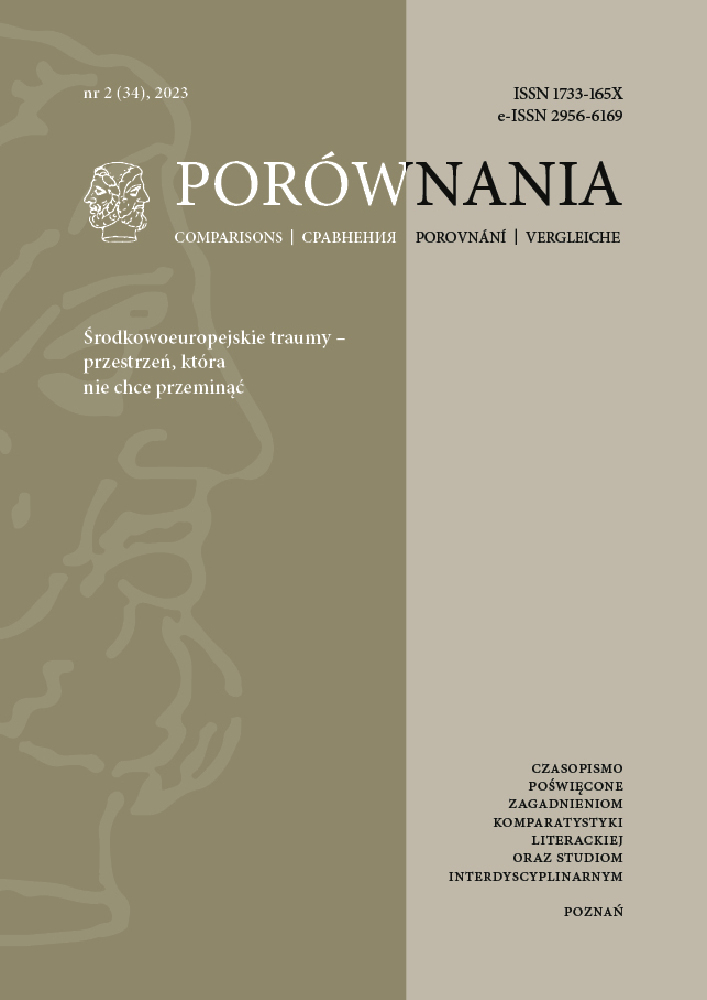Abstrakt
Menachem Kaiser’s Plunder: A Memoir of Family Property and Nazi Treasure (2021) critiques the generic limitations of the “3G” (third-generation) memoir by pointing to its frequently sentimental tenor and facile epiphanies, perpetuated by the publishing market. Plunder focuses instead on material traces of the past and on Kaiser’s effort to reclaim property left behind by his relatives in Poland. This approach allows Kaiser to address the aftermath of historical trauma without vicariously identifying with Holocaust victims or survivors.
Reference
Begnini, Roberto, dir. La vita è bella (Life Is Beutiful). Melampo Cinematografica, 1997.
Foer, Jonathan Safran. Everything Is Illuminated. Boston–New York: Houghton Mifflin, 2002.
Gilman, Sander L. “Is Life Beautiful? Can the Shoah Be Funny? Some Thoughts on Recent and Older Films.” Critical Inquiry 26.2 (2000): 279–308. DOI: https://doi.org/10.1086/448967
Hirsch, Marianne. Family Frames: Photographs, Narratives, and Postmemory. Cambridge, MA: Harvard University Press, 1997.
Kaiser, Menachem. Grabież. Historia majątku rodzinnego i nazistowskiego skarbu. Trans. Monika Skowron. Warszawa: Ośrodek Karta, 2023a.
Kaiser, Menachem. Kajzer: Mein Familienerbe und das Abenteuer der Erinnerung. Trans. Brigitte Hilzensauer. Vienna: Paul Zsolnay Verlag, 2023b.
Kaiser, Menachem. De nalatenschap: een zoektocht naar vergeten familiebezit, nazischatten en de betekenis van herinneringen. Trans. Fred Hendrikson. Amsterdam: Thomas Rap, 2021a.
Kaiser, Menachem. Plunder: A Memoir of Family Property and Nazi Treasure. Boston–New York: Houghton Mifflin Harcourt, 2021b.
Kajzer, Abraham. Za drutami śmierci. Wałbrzych: Muzeum Gross-Rosen w Rogoźnicy, 2021.
LaCapra, Dominick. Representing the Holocaust: History, Theory, Trauma. Ithaca–New York: Cornell University Press, 1994.
Lamparska, Joanna. Ostatni świadek. Historie strażników hitlerowskich skarbów. Kraków: Znak, 2022.
Loshitzky, Yosefa. “Holocaust Others: Spielberg’s Schindler’s List versus Lanzmann’s Shoah.” Spielberg’s Holocaust. Critical Perspectives on “Schindler’s List.” Ed. Yosefa Loshitzky. Bloomington–Indianapolis: Indiana University Press, 1997. 104–118.
Mendelsohn, Daniel. The Elusive Embrace. Desire and the Riddle of Identity. New York: Knopf, 1999.
Mendelsohn, Daniel. The Lost: The Search for Six of Six Million. New York: HarperCollins, 2006.
Navaro, Yael. “The Aftermath of Mass Violence: A Negative Methodology.” Annual Review of Anthropology 49 (2020): 161–173. DOI: https://doi.org/10.1146/annurev-anthro-010220-075549
Spielberg, Steven, dir. Schindler’s List. Universal Pictures and Amblin Entertainment, 1993.
Licence
Copyright (c) 2023 Tomasz Basiuk

Tato práce je licencována pod Mezinárodní licencí Creative Commons Attribution-NoDerivatives 4.0.
Utwory opublikowane w czasopiśmie „Porównania”, na platformie Pressto należącej do Uniwersytetu im. Adama Mickiewicza w Poznaniu są udostępniane na licencji Creative Commons Uznanie autorstwa - Bez utworów zależnych 4.0 Międzynarodowe (CC BY-ND 4.0)
Tym samym wszyscy zainteresowani są uprawnieni do korzystania z utworów opublikowanych pod następującymi warunkami:
-
uznania autorstwa — czyli obowiązek podania wraz z rozpowszechnianym utworem informacji o autorstwie, tytule, źródle (odnośniki do oryginalnego utworu, doi) oraz samej licencji
-
bez utworów zależnych — remiksując, przetwarzając lub tworząc na podstawie utworu, nie wolno rozpowszechniać zmodyfikowanych treści.
-
brak dodatkowych ograniczeń — nie można korzystać ze środków prawnych lub technologicznych, które ograniczają innych w korzystaniu z utworu na warunkach określonych w licencji.
Uniwersytet im. Adama Mickiewicza w Poznaniu zachowuje prawo do czasopisma jako całości (układ, forma graficzna, tytuł, projekt okładki, logo itp.).
Autor zachowuje prawa majątkowe, ale udziela zgody Uniwersytetowi im. Adama Mickiewicza w Poznaniu na wykorzystanie dzieła. Autorzy tekstów zakwalifikowanych do publikacji proszeni są o wypełnienie podpisanie i przesłanie umowa (PL) agreement (EN)
Agreement for granting a royalty-free license to works with a commitment to grant a CC sub-license





